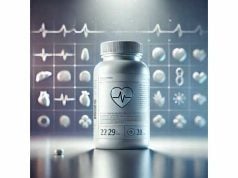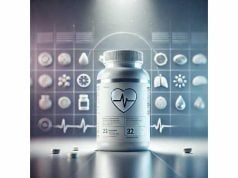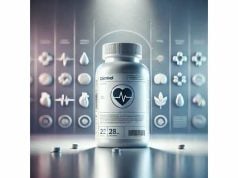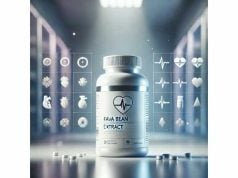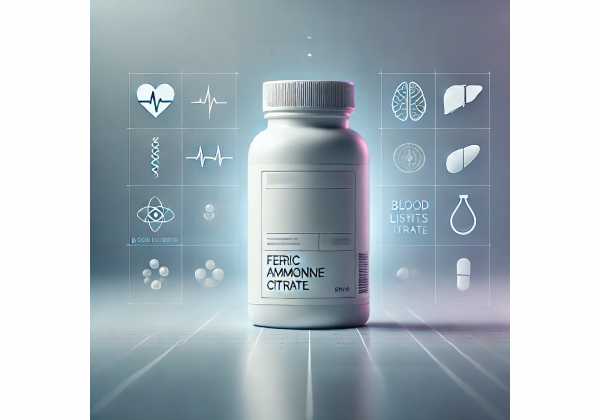
Ferric ammonium citrate (FAC) is a highly water-soluble iron(III) salt complexed with citric acid and ammonium. It has two common forms—green and brown—each with a different percentage of elemental iron. Because it dissolves easily and is relatively gentle on the stomach, FAC has been used for decades in food fortification, pediatric drops and syrups, and specialized lab media. In health contexts, its role is straightforward: it supplies non-heme iron to correct or prevent iron deficiency when diet alone is not enough. At the same time, FAC is not interchangeable with all other “ferric” products (for example, ferric citrate tablets used in chronic kidney disease are a different compound with different indications). If you’re considering FAC, it helps to understand how it works, when it’s appropriate, how to dose by elemental iron, what to expect, and who should avoid it.
At-a-Glance
- Corrects iron deficiency by supplying absorbable non-heme iron; useful when ferrous salts are not tolerated.
- Highly soluble; green and brown forms contain ~14.5–16.0% and ~16.5–22.5% elemental iron, respectively.
- Typical adult target: 40–65 mg elemental iron once daily or every other day; adjust per labs and clinical guidance.
- Safety: common GI effects (nausea, constipation, dark stools); keep out of children’s reach due to overdose risk.
- Avoid or use only with medical guidance in hereditary hemochromatosis, iron overload, or unexplained anemia.
Table of Contents
- What is ferric ammonium citrate?
- Does it help with anemia?
- How to take it and dose it
- Factors that change absorption
- Safety, risks, and who should avoid it
- What the evidence and guidelines say
What is ferric ammonium citrate?
Ferric ammonium citrate (FAC) is a coordination complex of iron(III), ammonia, and citric acid. Two forms are commercially available—green and brown—that differ slightly in composition and iron content. In food and pharmaceutical specifications, the brown salt typically assays at roughly 16.5–22.5% elemental iron, while the green salt contains about 14.5–16.0% elemental iron. Both forms are very soluble in water and insoluble in ethanol, which helps explain why FAC appears in liquid preparations (drops and syrups) and in foods where uniform dispersion is important.
Beyond nutrition, FAC shows up in several niche but noteworthy applications. It provides the ferric ions that, together with potassium ferricyanide, form the deep “Prussian blue” images in cyanotype printing (the original “blueprint” process). In microbiology, FAC supplies iron in specialized media that detect hydrogen sulfide production by certain bacteria. In food technology, it appears as a nutrient and, depending on the form, as an anticaking agent for sodium chloride. These non-medical uses don’t change how your body handles FAC when it’s taken by mouth for iron replenishment, but they help contextualize why this particular iron salt is so widely manufactured and standardized.
From a physiology standpoint, FAC delivers non-heme iron in the ferric (Fe³⁺) state. In the upper small intestine, ferric iron must be reduced to ferrous (Fe²⁺) to cross the intestinal membrane through the DMT1 transporter. The citrate ligand in FAC keeps iron in solution across a range of stomach acid conditions, supporting availability for reduction and uptake. That’s useful if you take acid-suppressing medications (like PPIs), although absorption still depends on several variables you can influence (timing with meals, vitamin C) and some you can’t (inflammation via hepcidin).
FAC is not the same as ferric citrate tablets used in chronic kidney disease or as a phosphate binder. Although both contain ferric iron complexed with an organic acid, they differ in composition, dose, indications, and safety monitoring. Likewise, ferric carboxymaltose is an intravenous formulation with its own profile and should not be confused with oral FAC.
In practice, FAC’s appeal lies in its solubility, neutral taste in liquids, and the ability to deliver modest, titratable amounts of elemental iron—particularly helpful in pediatrics and in adults who find standard ferrous salts harsh on the stomach. If you see FAC on a label, look for “elemental iron” in milligrams; that’s the number that matters for dosing.
Does it help with anemia?
Yes—when iron deficiency is the cause. Regardless of the salt used, oral iron corrects iron deficiency anemia (IDA) by restoring hemoglobin and replenishing ferritin (iron stores). FAC is one of several oral options that can accomplish this, provided the dose supplies enough elemental iron and the person can absorb it. In children and adults, low-dose oral iron can improve hematologic markers over weeks, with symptom relief (less fatigue, better exercise tolerance) often emerging as hemoglobin rises.
Where does FAC fit compared with ferrous sulfate or other ferrous salts? Modern guidelines emphasize that no single oral formulation has proven superior in head-to-head outcomes; ferrous sulfate is generally preferred on the basis of price and availability. That said, for people who experience intolerance (nausea, epigastric discomfort, constipation) or strong taste aversion with ferrous tablets, switching the form—and especially the formulation—can be a practical solution. FAC, particularly in liquid syrups or drops, can be easier for children and some adults to take consistently. Consistency is key: poor adherence is a common reason iron indices fail to rise.
Evidence in pediatrics illustrates how a low daily dose of elemental iron delivered as FAC syrup can correct deficiency with good tolerability. In one study protocol, each 5 mL of syrup provided 57.51 mg ferric ammonium citrate (equivalent to 10 mg elemental iron), and daily administration improved hematologic indices while favorably affecting oxidative stress markers over eight weeks. This doesn’t imply that 10 mg/day fits every child; pediatric dosing is typically weight-based, and clinicians adjust to lab values and clinical response. The takeaway is that FAC can be an effective vehicle for delivering small, steady amounts of iron, which some children tolerate better than larger bolus doses.
In adults, using once-daily or every-other-day regimens—rather than multiple divided doses—can improve absorption efficiency and reduce gastrointestinal side effects. Elemental iron targets often start around 40–65 mg per day and are adjusted based on hemoglobin, ferritin, transferrin saturation, and the underlying cause of iron loss (e.g., heavy menses, occult GI bleeding). FAC can meet these elemental targets, but you must translate the label’s FAC content into elemental iron (see the dosing section for examples).
Finally, it’s important to separate iron deficiency from other causes of anemia. If anemia stems from chronic inflammation, renal disease, B12/folate deficiency, hemolysis, or bone marrow conditions, or if there’s ongoing blood loss, oral iron alone may be insufficient. In such cases, intravenous iron or disease-specific therapy might be indicated. When the diagnosis is uncertain—especially in adult men and postmenopausal women—evaluation for gastrointestinal blood loss is standard practice alongside iron repletion.
How to take it and dose it
Dose by elemental iron, not by milligrams of FAC. Product labels should list elemental iron (the amount your body can use) and the corresponding milligrams of ferric ammonium citrate. Because FAC comes in green and brown forms with different iron percentages, two products with the same “mg of FAC” can deliver different elemental iron. When in doubt, use the elemental number for decisions.
Adult starting point: Many clinicians begin with 40–65 mg elemental iron once daily or every other day, then adjust. This schedule limits hepcidin spikes and may improve absorption and tolerability compared with multiple daily doses. Take FAC on an empty stomach if you can; if not, a small snack is acceptable—consistency beats perfection.
Pediatric considerations: Children typically receive weight-based elemental iron prescribed by a clinician. FAC syrups and drops are common because they allow fine-tuning by milliliter and are easier to swallow. As one example from clinical research, some syrups deliver 10 mg elemental iron per 5 mL (derived from ~57.5 mg FAC). Your child’s specific dose should come from their healthcare professional, guided by labs and age.
How to translate FAC to elemental iron (illustrative examples):
- If a label says “Green FAC 300 mg per tablet,” estimate elemental iron ~15% → ~45 mg elemental iron per tablet.
- If a syrup states “57.5 mg FAC per 5 mL equals 10 mg elemental iron,” then 5 mL = 10 mg elemental; 10 mL would give 20 mg elemental.
Timing and food: Vitamin C (e.g., a small glass of orange juice or 100–200 mg ascorbic acid) can enhance non-heme iron absorption. Coffee, tea, calcium supplements, antacids, and high-phytate meals (bran cereals/legumes) can inhibit absorption if taken simultaneously. Separate these by at least two hours when practical.
How long to take it: Expect a hemoglobin rise of ~1–2 g/dL over 3–4 weeks if dosing and absorption are adequate. Continue therapy for at least 3 months after hemoglobin normalizes to replete iron stores (ferritin), then reassess. Some people with ongoing losses (heavy menstrual bleeding, frequent blood donation) may need maintenance strategies.
If you miss a dose: Take it when you remember unless it’s close to your next dose. Avoid doubling up; just resume your regular schedule.
When oral FAC is not enough: If you have persistent intolerance, poor absorption (e.g., bariatric surgery, active inflammatory bowel disease), or you don’t meet targets despite adherence, discuss intravenous iron with your clinician.
Drug interactions to know: Iron binds many medications and lowers their absorption. Common examples include levothyroxine, tetracyclines, fluoroquinolones, and some osteoporosis meds. Separate dosing according to your prescriber’s guidance (often by 2–4 hours). Conversely, proton pump inhibitors (PPIs) reduce stomach acid and can diminish non-heme iron uptake; spacing iron away from PPI dosing or using vitamin C may help.
Factors that change absorption
1) Iron form and solubility. FAC is highly water-soluble, which supports availability for reduction to ferrous iron before transport across the intestinal lining. That property can help in settings of lower gastric acidity. Still, solubility is just the starting point—absorption depends on the interplay of diet, dosing schedule, and body signals.
2) Hepcidin and inflammation. Hepcidin is the liver-derived hormone that gates iron absorption and release from stores. Inflammation (from infection, autoimmune disease, or chronic conditions) raises hepcidin, suppressing iron uptake. Even the best oral formulation will underperform if hepcidin is high. In such cases, clinicians may treat the underlying inflammation first or choose intravenous iron.
3) Dosing frequency. Once-daily or every-other-day elemental iron appears to avoid repeated hepcidin spikes and can achieve similar or better net absorption than multiple daily doses, while often causing fewer GI side effects. This is a practical lever you can pull without changing the compound.
4) Cofactors and inhibitors.
- Enhancers: Vitamin C, meat/fish/poultry (“meat factor”), and a generally mixed diet.
- Inhibitors: Calcium supplements, dairy taken with iron, polyphenols (coffee/tea), and phytates (bran, legumes) when consumed at the same time. Spacing helps.
5) Gastric acidity. Non-heme iron absorption benefits from acidic conditions. Acid-suppressing drugs (PPIs, H₂ blockers) may dampen absorption. If you need these medications, taking iron at a different time of day and pairing with a vitamin C source can offset some impact.
6) Baseline iron status. Paradoxically, people with the lowest ferritin often absorb iron more efficiently (low hepcidin), while those with modest deficiency absorb less. This is another reason to monitor labs and tailor dose rather than chasing a universal milligram target.
7) Product details. With FAC, check whether the product uses the green or brown salt and whether it lists elemental iron per dose. Liquids allow finer dose control and may be preferable in dose-sensitive scenarios (pediatrics, GI sensitivity). Tablets and capsules can be convenient for adults if the elemental content matches your target.
8) The underlying cause. If heavy menstrual bleeding, GI bleeding, or frequent blood donation continues unchecked, oral iron becomes a band-aid. Addressing the cause is what makes iron repletion “stick.”
Practical absorption checklist (for most people):
- Choose a dose that provides ~40–65 mg elemental iron per day to start.
- Take it once daily or every other day, ideally away from tea/coffee/calcium.
- Add a small vitamin C source.
- Recheck CBC and ferritin in 3–4 weeks; adjust as needed.
- If no response—and adherence is good—ask about inflammation, malabsorption, or IV iron.
Safety, risks, and who should avoid it
Common, usually mild effects: Nausea, a “metallic” taste, abdominal discomfort, constipation or loose stools, and dark stools are the most frequent experiences with oral iron, including FAC. Taking iron with a small snack can help if stomach upset is a problem (even if absorption is slightly lower). Liquid FAC can stain teeth—use a straw and rinse afterward if this occurs.
Overdose caution (especially in children): Iron overdose is dangerous. Always store FAC out of reach. Symptoms of acute toxicity include severe abdominal pain, vomiting, diarrhea (sometimes bloody), and lethargy. Emergency care is required for suspected ingestion well above prescribed doses.
Who should avoid or use only under close medical supervision:
- Hereditary hemochromatosis or other iron overload disorders. Additional iron can worsen organ damage.
- Chronic hemolytic anemia or repeated transfusions. You may already have excess iron.
- Active, unexplained anemia. Get evaluated before starting iron—treating blind can delay diagnosis of serious conditions (e.g., GI bleeding, celiac disease).
- Known hypersensitivity to product components.
- Significant inflammatory states with high hepcidin (poor oral response)—IV iron may be preferred.
Medication interactions (space doses): Levothyroxine, tetracyclines, fluoroquinolones, bisphosphonates, some Parkinson’s drugs (levodopa/carbidopa), and zinc supplements can be affected by iron co-administration. Your clinician or pharmacist can provide specific spacing guidance.
Pregnancy and lactation: Iron needs rise in pregnancy, but dosing and the ideal formulation should be individualized by the obstetric provider. FAC can supply elemental iron; however, many prenatal regimens use standard ferrous salts for simplicity and cost.
Upper limits: For healthy adults, tolerable upper intake levels (ULs) for iron from all sources are set to minimize adverse effects. Exceeding these regularly without medical oversight is not recommended.
Distinct from IV ferric carboxymaltose: Intravenous ferric carboxymaltose carries unique risks (notably hypophosphatemia) that do not apply to oral FAC. Don’t conflate these names—despite both starting with “ferric,” they are different compounds with different risk profiles and uses.
Allergy and intolerance: True allergy to iron salts is rare. Most “intolerance” reflects GI side effects. Trying a different formulation (e.g., liquid FAC instead of a ferrous tablet) or changing the schedule (every-other-day) often solves the problem.
When in doubt, partner with your healthcare professional: iron therapy is simple in concept but benefits from lab-guided, cause-guided adjustments.
What the evidence and guidelines say
Specifications and composition. International monographs specify that brown FAC contains roughly 16.5–22.5% elemental iron and green FAC 14.5–16.0%. Both are very soluble in water. These specifications support why FAC appears in foods and in liquid supplements: reliable iron content and easy dispersion.
Clinical guidance on oral iron. Contemporary practice guidance emphasizes simple, tolerable regimens: use oral iron once daily at most; every-other-day can perform similarly with fewer side effects. No oral iron salt is consistently superior in outcomes; ferrous sulfate is generally favored for cost. Vitamin C co-administration can enhance absorption. Intravenous iron is reserved for intolerance, malabsorption, or failure to respond.
Pediatric angles. Reviews of iron deficiency in children reiterate that oral iron is first-line for most cases, with dose, formulation, and duration tailored to age, severity, and comorbidities. FAC syrups illustrate a practical approach to delivering small, consistent elemental iron doses with good tolerability; in one protocol, 10 mg elemental iron daily improved hematologic and oxidative stress measures over eight weeks. Nonetheless, weight-based dosing and follow-up labs remain essential.
Anemia workup principles. Adult men and postmenopausal women with iron deficiency anemia warrant evaluation for gastrointestinal blood loss while receiving iron replacement. Guidelines provide algorithms for diagnosis, treatment, and when to opt for IV iron.
FAC in the broader landscape. Oral iron comes in many forms—ferrous (sulfate, fumarate, gluconate) and ferric complexes (including FAC). What matters clinically is the elemental iron delivered, the schedule, tolerability, and adherence. In that framework, FAC is a legitimate option—especially in liquids and pediatric regimens—so long as dosing targets and follow-up are appropriate.
Bottom line: FAC can correct iron deficiency when dosed by elemental iron and taken consistently. It occupies a practical niche where solubility, liquid dosing, and gentler GI profiles matter, but it is neither uniquely potent nor a substitute for diagnostic evaluation of the anemia’s cause.
References
- FERRIC AMMONIUM CITRATE 2006 (Monograph).
- AGA Clinical Practice Update on Management of Iron Deficiency Anemia: Expert Review 2024 (Guideline/Expert Review).
- British Society of Gastroenterology guidelines for the management of iron deficiency anaemia in adults 2021 (Guideline).
- Iron – Health Professional Fact Sheet 2024 (Government Fact Sheet).
- Low Dose Iron Therapy in Children with Iron Deficiency 2021 (Clinical Study).
Disclaimer
This article is for educational purposes only and does not replace personalized medical advice, diagnosis, or treatment. Iron deficiency has many causes, and dosing should be individualized using laboratory tests and clinical evaluation. Do not start, stop, or change any medication or supplement—including ferric ammonium citrate—without guidance from a qualified healthcare professional. In suspected overdose or severe symptoms, seek emergency care immediately.
If you found this helpful, consider sharing it on Facebook, X (formerly Twitter), or your preferred platform, and follow us for future evidence-based guides. Your support helps us continue creating high-quality content.


